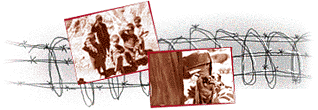
|
HOME |
NEWS |
REDIFF DIARY
|
Chindu Sreedharan |
|
It was a small group, about five women -- one of them who looked as old as the hills -- and two children. They were waiting for transportation to Somat, an Indian village away from the Line of Control. "We have relatives there, but they are safe in Somat," says Kathija, a woman of 20-something. Kathija's village is Toko-Chaukyal. Three hours earlier it recorded another 'hit', its third, from Pakistani shells. Now the entire village of around 120 people in in the process of moving out to safer areas. Just about 500 m from the Srinagar-Leh road towards the Line of Control in Kashmir, Toko is the latest village where the ongoing Indo-Pak artillery exchanges have caused large-scale migration. Dras, which we left behind some 50 minutes ago, was in troubled isolation. On both sides of the road, the main market had all its shops closed, and the pockmarked mud brown buildings boasted not a soul inside. The only people around were a couple of Jammu and Kashmir policemen and a few locals, probably staying back as caretakers in the town which has been deserted since May 13, when it was shelled for the first time since Independence. "Shelling has been going on here since morning," the policemen had told us, "But for the last hour it has been quiet." All the way from Srinagar, as part of the first media party permitted into the troubled Dras-Kargil area, we had been warned that "medium shelling" was continuing along the route. Some 20 km before Dras, we heard the Bofors guns opening up on Pakistani troops from the hill above. Ten minutes later there was another. And another. After Dras, we could see rows of guns to our right, giving us the distinct feeling that we have entered a war zone. Now in Chaukyal, we are witnessing something we have been reading about for so many days -- a whole village migrating to safer areas. "The shell fell 'there' from our house," says Kathija, indicating the distance by pointing at a vehicle some 700 metres away. "Everyone was inside or else someone would've been hurt. Splinters damaged our house." Muhammad Sultan, an old, bespectacled man from another village nearby, Beres, joined the group. "Bahut buri halat hai, saab," he says, "Raat din shelling hota hi rahta hai. We are moving to save our lives." The stocky gentlemen we see a little way off, the villagers inform us, is the local magistrate. Looking a bit out of place in his glasses and hat, he braces himself against the powerful, dust-swirl and introduces himself as Barkat Ali. Besides Toko, he informs us, there have been many other villages in his area that are now moving out. Luckily there was no civilian casualties in this area, he claimed. We move towards Toko, on the way meeting another family coming down. "Gola lag gaya saab," says Gulam Ahmed, the head of the group. "We are moving out to Donghok (another hamlet deeper in Indian territory)." At Toko, our guide, a little one named Muzaffar, points out where the shell landed. It is on the slopes, not very far from the houses. There is no one in the village. The only living soul left is a black cow which, tethered in the shelter of buildings, watches us with curious eyes. We drop Muzaffar back and move on. There is another 48 km before we know what Kargil, which received heavy shelling on Monday, holds for us. Rediff Correspondent Chindu Sreedharan wrote this piece in Kargil
|
||
|
HOME |
NEWS |
BUSINESS |
SPORTS |
MOVIES |
CHAT |
INFOTECH |
TRAVEL |
SINGLES BOOK SHOP | MUSIC SHOP | GIFT SHOP | HOTEL RESERVATIONS | WORLD CUP 99 EDUCATION | PERSONAL HOMEPAGES | FREE EMAIL | FEEDBACK |
||
